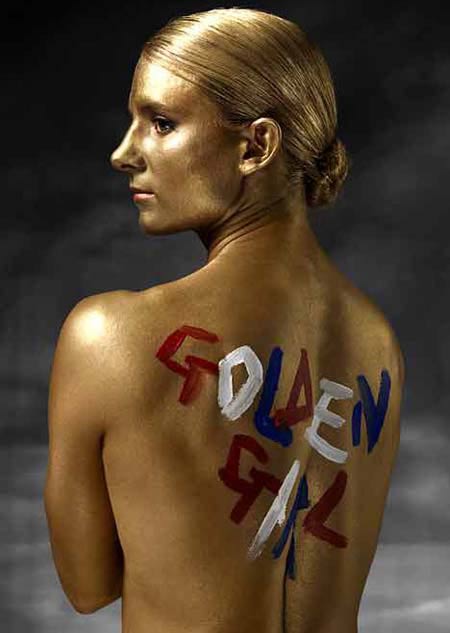Unsportsmanlike Conduct
by Richard Vincente

I attended my first LPGA tournament in Canada last week and, although I thoroughly enjoyed the experience, it reminded me of a sadly enduring truth: people can be pigs.
I presumed the fairways would be lined with serious golf fans, but it seemed like many people thought they were really attending a fashion show or a bachelor party. I spent much of the day eavesdropping on whispered crowd chatter. And much of what I overheard was shockingly, regressively sexist.
Many men in the crowd were less interested in a golfer’s skills (which were seriously impressive) than in her legs, boobs, butt, hair and overall do-ability. I lost track of how many times I heard someone mutter a predictable pun about scoring or balls or shafts.
But it wasn’t just men doing the sniping from the sidelines. I listened in as female spectators swapped opinions on the players’ weight, age, fashion choices and attitude. “My, she’s a big girl, isn’t she?” or “She’s a pretty thing, wouldn’t you say?”
And when players bent down to retrieve their balls from the cup, many in the gallery – men and women alike – leaned forward, hoping to get a peek at their underpants.
This kind of thing must drive women athletes nuts. Whether they are golfers or soccer players or swimmers or gymnasts, they devote their lives to achieving the highest possible standard of performance … only to be viewed (by some) as contestants in a beauty pageant, evaluated by the same criteria as a runway model or centerfold.
Admittedly, some women athletes parlay their good looks and toned physiques into lucrative endorsement and even modeling deals (one LPGA star from Korea is known in her home country as “the supermodel of the fairways”). But the vast majority pursue athletic goals alone, and silently endure the sexist fog that envelops women’s sport.

We’re going to see a lot of this in the weeks ahead as the London Olympics dominate the news and the complex culture of women’s athletics gets more attention. (Already we’ve seen controversy surrounding chromosome verification involving some Africa athletes, and a bizarre debate over whether female boxers should be allowed to NOT wear little mini-skirts in the ring.) There’s even a website (http://www.olympicgirls.net) that catalogues the world’s hottest sport babes and offers the most revealing images of them available.
And female Olympians who embrace, rather than ignore, their sensual selves tread a fine line between self-promotion and unsportsmanlike conduct. Last month, for example, Australian gold medal-winning swimmer Stephanie Rice found herself the subject of intense criticism after she tweeted the above photo of herself in a sexy swimsuit. Despite the fact she swims for a living. Go figure.
Olympic purists might not be offended by that example, but they are probably less forgiving when Olympic women start disrobing in public – for whatever reason.
That’s UK windsurfer Bryony Shaw in the main, top photo above, who was one of several British Olympians who were photographed in body paint to promote their appearance at the 2008 Beijing Games. That project recalled a similar promotional effort at the 2004 Games, when members of Britain’s women’s sailing team posed nude for a fundraising calendar.

Earlier this year, British lingerie designer Nichole De Carle recognized the almost primal sexual appeal of women athletes when she created a stunning calendar featuring members of Great Britain’s 2012 Olympic team – a project that gave enormous exposure to both the Olympians and De Carle’s label, while raising money for a women’s health charity. It was a bold project, and tastefully executed, which may be why it didn’t turn into a chest-thumping national controversy.
More recently, the Canadian women’s rugby team – probably the roughest, unsexiest women’s sport outside of kickboxing – raised eyebrows when they published a racy calendar featuring its members nude or semi-nude. Their reason? To raise funds for their Olympic and World Cup training, which tells you a lot about sports funding in this country.


But the Canadian team (which has done this kind of calendar several times) wasn’t just catering to prurient tastes; they are also trying to promote a new standard of physical beauty. “Having muscles is very beautiful and being physically fit is very attractive,” said team member Barbara Mervin. “We are elite athletes and we are proud of our bodies. … We hope we can help young girls to know that you can be 170 pounds and be absolutely beautiful.”
Having said that, Mervin admits that the $20 calendars are far more effective at raising money for the team than other, less provocative fundraising tools. When it comes to women’s athletics, like everything else, sex is what sells.
In a way, there’s nothing really wrong with that, so long as it doesn’t obscure the women’s performance on the field. In the end, women athletes would much rather earn a gold medal than a Maxim photo shoot.
Richard Vincente is the editor of Lingerie Talk, Canada’s leading lingerie news site.

